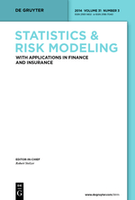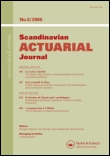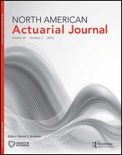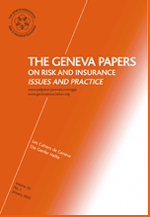
Geneva Risk and Insurance Review
Scope & Guideline
Fostering dialogue on contemporary risk challenges.
Introduction
Aims and Scopes
- Risk Economics and Theory:
Explores foundational concepts in risk theory and economics, often examining how theoretical models apply to real-world insurance markets. - Insurance Market Analysis:
Analyzes various aspects of insurance markets, including competition, pricing strategies, and consumer behavior, with a focus on empirical evidence. - Health Insurance and Welfare Economics:
Investigates the interplay between health insurance systems, individual welfare, and public health outcomes, particularly in the context of policy implications. - Behavioral Economics in Insurance:
Examines how psychological factors influence risk perceptions and insurance demand, integrating behavioral economics into traditional insurance models. - Sustainability and Risk Management:
Addresses the challenges and strategies related to sustainability in insurance, particularly in the face of climate change and extreme weather events. - Development and Emerging Markets:
Focuses on the unique challenges of insurance in developing countries, including risk management practices and the role of insurance in economic development.
Trending and Emerging
- Big Data and Privacy Concerns:
The integration of big data in risk classification and the associated privacy implications is gaining traction, highlighting the need for ethical considerations in data usage. - Health Risk and Economic Behavior:
Research focusing on the intersection of health risks and economic behaviors, particularly in self-protection and health insurance, is on the rise, reflecting growing public health concerns. - Sustainability and Extreme Events:
Investigations into sustainability actions under uncertainty and the implications of extreme weather events are emerging as critical areas of study, driven by increased awareness of climate change. - Behavioral Insights in Insurance Decision-Making:
There is an increasing emphasis on understanding how cognitive biases and risk preferences influence insurance decisions, indicating a shift towards behavioral economics. - Insurance in Developing Contexts:
A growing body of research is dedicated to understanding insurance mechanisms in developing countries, addressing unique challenges and opportunities in these markets.
Declining or Waning
- Traditional Risk Models:
There seems to be a waning focus on purely traditional risk models without considering behavioral or market-based factors, indicating a shift towards more integrated approaches. - Static Analysis of Insurance Products:
Research that merely evaluates insurance products without considering dynamic market changes or consumer behavior is becoming less frequent. - Pensions and Long-Term Care Insurance:
Although still relevant, the frequency of publications specifically addressing pensions and long-term care insurance has decreased, possibly due to a broader focus on immediate health risks and insurance. - Generalized Insurance Theories:
Theoretical explorations that do not incorporate contemporary issues such as big data, privacy, and technology are receiving less attention, suggesting a trend towards more applied research.
Similar Journals

Statistics & Risk Modeling
Fostering a deeper understanding of statistical science in practice.Statistics & Risk Modeling is a distinguished journal published by WALTER DE GRUYTER GMBH, focusing on the intricate relationships between statistical methodologies and risk assessment techniques. With a strong academic foundation, the journal has been an influential platform in its field since its inception, converging contributions from 1982 to 2002 and again from 2011 to 2024. This journal is currently ranked in the Q3 category in both Modeling and Simulation and Statistics and Probability, reflecting its commitment to advancing knowledge and promoting robust research in statistics, probability, and uncertainty analysis. Although it offers a traditional subscription model, its significant contribution to the community is underscored by its increasing visibility in Scopus rankings, where it stands in the 44th percentile for Decision Sciences and Statistics. By comprehensively addressing contemporary issues in statistical theory and its practical applications, Statistics & Risk Modeling serves as an essential resource for researchers, professionals, and students aiming to deepen their understanding of statistical science and its implications in risk management.

Economics of Governance
Decoding the Dynamics of Governance and Economic Success.Economics of Governance (ISSN: 1435-6104; E-ISSN: 1435-8131) is a distinguished journal published by SPRINGER HEIDELBERG, dedicated to advancing the field of governance economics. Established in 2003, this journal explores the intricate relationships between governance structures and economic performance, making it a vital resource for researchers, practitioners, and policymakers alike. With its impressive categorization in Q3 in Business and International Management and Q2 in Economics, Econometrics, and Finance (miscellaneous) as of 2023, it stands as a prominent platform for innovative research. Although it operates without open access, it attracts a robust readership owing to its critical analyses and high-quality contributions, fostering an understanding of governance mechanisms in a globalized economy. The journal also receives recognition within Scopus, ranking #139 in General Economics and #323 in Business and International Management, reflecting its influence in shaping current discourse and research trends. For those devoted to the economics of governance, this journal is a crucial asset that continually encourages scholarly inquiry and professional development.

METHODOLOGY AND COMPUTING IN APPLIED PROBABILITY
Advancing the frontier of applied probability and computation.METHODOLOGY AND COMPUTING IN APPLIED PROBABILITY is a distinguished journal published by SPRINGER, dedicated to advancing research in applied probability and its relationship with various computational methodologies. With an ISSN of 1387-5841 and an E-ISSN of 1573-7713, this journal provides a platform for innovative studies that bridge theory and practical application in the field of mathematics and statistics. Ranking in the Q2 category for Mathematics (miscellaneous) and Q3 for Statistics and Probability as of 2023, it reflects a robust academic discourse, featuring contributions that span a range of methodologies utilized in probability-related studies. The journal's sustained engagement in the academic landscape from 2004 to 2024 puts it at the forefront of ongoing developments in statistics and probability. Researchers, professionals, and students alike will find the insights found within to be invaluable for both theoretical understanding and practical implementation.

Scandinavian Actuarial Journal
Elevating academic standards in actuarial and statistical research.The Scandinavian Actuarial Journal, published by Taylor & Francis Ltd, stands as a pivotal resource in the fields of Economics, Econometrics, Statistics, and Probability, with a legacy dating back to 1918. This esteemed journal, headquartered in the United Kingdom, offers valuable insights and comprehensive research findings that contribute significantly to the actuarial and statistical communities. With its impressive 2023 quartile rankings—Q1 in both Statistics and Probability, and in Statistics, Probability and Uncertainty, as well as Q2 in Economics and Econometrics—this journal is recognized for its high-quality peer-reviewed content, making it indispensable for researchers, professionals, and students alike. Although it currently does not operate under an Open Access model, the journal ensures rigorous academic standards and broad visibility within its field. With a Scopus rank placing it in the top quartile of relevant categories, the Scandinavian Actuarial Journal is committed to advancing knowledge and fostering innovation in statistical methodologies and insights.

Journal of Risk
Navigating the Intricacies of Financial RiskJournal of Risk, published by INCISIVE MEDIA, serves as an essential platform for scholars and practitioners in the fields of finance and strategic management. With an ISSN of 1465-1211 and an E-ISSN of 1755-2842, this journal explores the multifaceted nature of risk, encompassing theoretical frameworks, empirical investigations, and practical applications. Although currently classified in Q4 for both Finance and Strategy and Management categories as per 2023 standards, it provides a crucial forum for innovative research and thought leadership, addressing the challenges faced in understanding and managing risk in today’s dynamic environment. The journal, based in the United States, is committed to advancing knowledge and offering a platform for debate and dialogue in its convergence years from 2011 to 2024. Researchers, professionals, and students are encouraged to contribute their insights to enhance the academic discourse surrounding risk management.

North American Actuarial Journal
Exploring the Frontiers of Actuarial ScienceNorth American Actuarial Journal is a prominent publication in the fields of Economics and Econometrics, Statistics and Probability, and Statistics, Probability and Uncertainty, published by Routledge Journals, Taylor & Francis Ltd. The journal, with the ISSN 1092-0277 and E-ISSN 2325-0453, covers critical advancements in actuarial science over the years from 1997 to 2024. With a strong Q2 ranking in multiple categories for 2023, the journal positions itself as a vital resource for researchers and practitioners looking to stay abreast of current trends and methodologies in actuarial practices. The journal’s focus on providing a platform for high-quality research makes it indispensable for professionals and academics alike, offering insightful contributions that influence the actuarial field's evolution. While it currently does not offer open access options, its rigorous peer-review process ensures the integrity and relevance of its published works. Researchers, professionals, and students in actuarial science will find this journal to be a valuable asset for both their studies and professional development.

Journal of Insurance Issues
Unpacking the Dynamics of Insurance Economics and PolicyJournal of Insurance Issues, published by the Western Risk & Insurance Association, stands as a pivotal platform for the exploration and dissemination of knowledge in the field of insurance and risk management. With an ISSN of 1531-6076 and an E-ISSN of 2332-4244, this journal delves into the complexities and evolving dynamics of insurance practices, policies, and theoretical underpinnings. Although not an open-access journal, it remains accessible to a broad audience, including academics, practitioners, and students eager to engage with rigorous research and innovative ideas. The journal is dedicated to enhancing understanding in critical areas such as risk assessment, regulatory impacts, insurance economics, and consumer behavior, thereby contributing significantly to the professional discourse within the insurance sector. Its robust editorial standards ensure that published works meet high-quality scholarly criteria, further establishing the journal as an essential resource for anyone interested in the multifaceted world of insurance.

Risks is an esteemed Open Access journal published by MDPI, based in Switzerland, dedicated to exploring multifaceted dimensions of risk across various fields, including Accounting, Economics, Finance, and Management. Since its inception in 2013, the journal has fostered academic discourse by providing a platform for high-quality research that addresses contemporary challenges and theoretical advancements within these disciplines. With a commendable ranking in the 75th percentile for Economics, Econometrics and Finance, and distinction in Accounting and Strategy Management, Risks maintains robust academic quality that resonates within the global research community. The journal not only prioritizes accessibility with its Open Access model but also aims to bridge the gap between academia and industry through rigorous peer-reviewed publications. Researchers, professionals, and students alike will find Risks to be an invaluable resource for innovative insights and evidence-based analyses in the field of risk management.

GENEVA PAPERS ON RISK AND INSURANCE-ISSUES AND PRACTICE
Illuminating Key Issues in Risk and InsuranceGENEVA PAPERS ON RISK AND INSURANCE-ISSUES AND PRACTICE is a leading academic journal dedicated to advancing the fields of risk management and insurance, published by the esteemed Palgrave Macmillan Ltd. With an ISSN of 1018-5895 and an E-ISSN of 1468-0440, this journal serves as a pivotal platform for sharing cutting-edge research and practical insights addressing a diverse range of issues within the insurance sector. Established in 1999, it spans a wide array of topics, including risk assessment, financial implications, and policy development, contributing to its recognition in the Q2 quartile across multiple categories such as Accounting and Economics. With a notable Scopus ranking reflecting its relevance—ranked #229/716 in Economics and Econometrics, and #106/317 in Finance—it provides invaluable resources for scholars, professionals, and policymakers alike. Despite being a non-open-access journal, the GENEVA PAPERS ensures a rigorous peer-review process, aiming to uphold the highest standards of scholarly publication. Whether you are a researcher looking to publish groundbreaking studies or a practitioner seeking the latest trends and analyses in the insurance landscape, this journal stands out as an essential resource in the domain.

Revue de l IRES
Navigating the Intersection of Economics and SocietyRevue de l'IRES is a distinguished journal published by the Institut de Recherches Économiques et Sociales (IRES), specializing in economic and social sciences. With the ISSN 1145-1378, this journal contributes significantly to the academic discourse by publishing high-quality research that addresses contemporary issues in the field. Although it does not currently operate under an Open Access model, it provides valuable insights through its rigorous peer-review process, ensuring the integrity and scholarly quality of its content. The journal is based in France, with its operations centered at 16 Boulevard Mont Est, 9ième étage, Noisy-le-Grand. Researchers, professionals, and students are encouraged to engage with the research published in Revue de l'IRES, which serves as a critical platform for advancing knowledge and policy-oriented discourse in economics and social sciences.